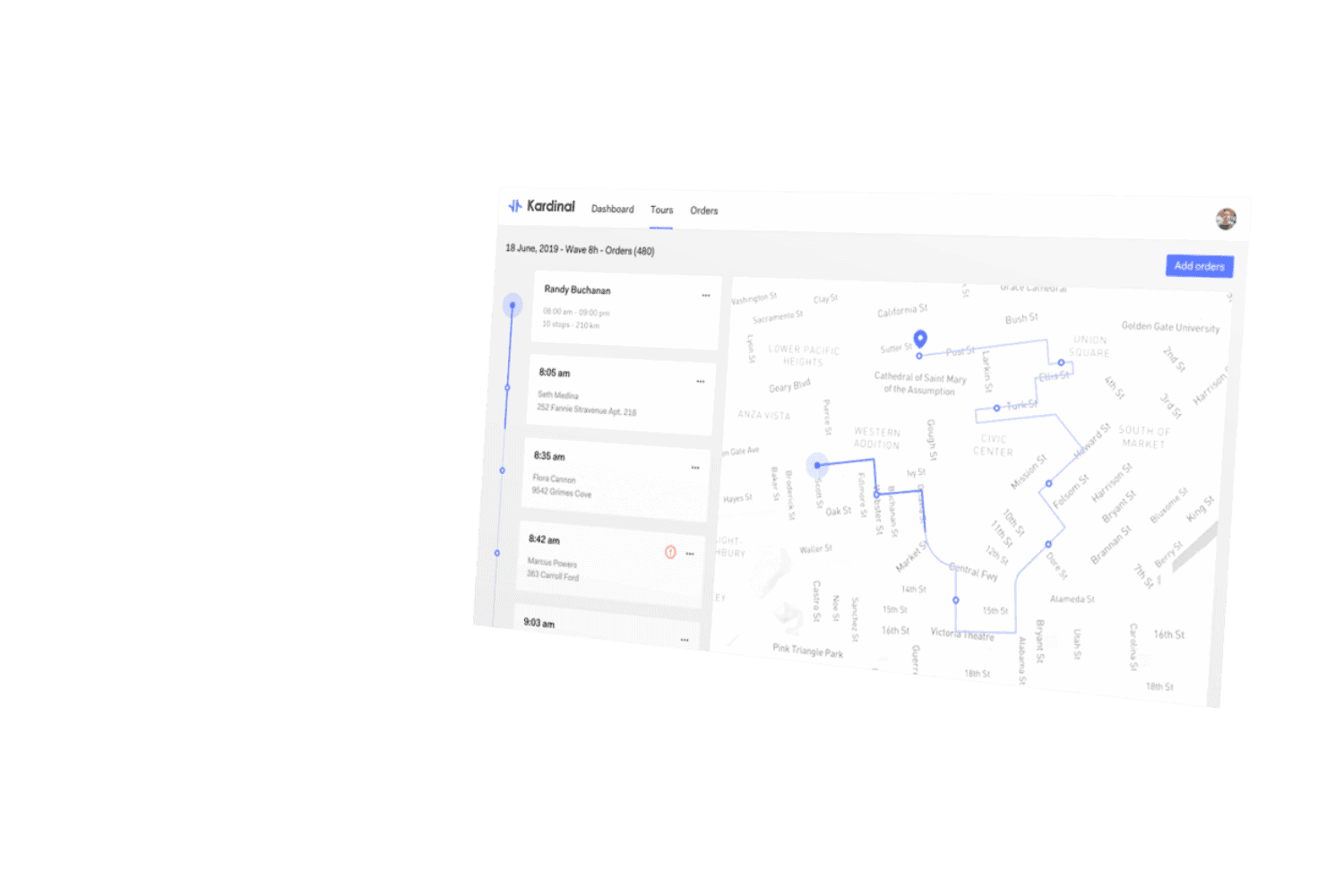For a long time, route optimization was seen as nothing more than a way to calculate efficient itineraries.
In just a few years, however, it has become a strategic lever for logistics and transport organizations.
As logistics challenges grow more complex (rising costs, increasing customer expectations, sustainability pressures, and labor shortages) the ability to intelligently organize operations has become a real competitive advantage.
But behind the term “route optimization” lies a vast and diverse ecosystem of software solutions, each with different levels of expertise, ambitions, and promises.
TMS, DMS, SaaS solutions, or embedded optimization modules, it’s getting harder and harder to tell them apart.
That’s why Kardinal offers here a structured overview of this evolving market, based on our experience working alongside major logistics and transport players.
Objective: to clarify the roles, strengths, and limitations of each category of solution, so you can better understand how to combine them, or tell them apart.
A market in transformation
Today, the route optimization market is part of an increasingly fragmented ecosystem, made up of solutions with very different objectives. Alongside specialized route optimization tools, there are TMS (Transport Management Systems) and DMS (Delivery Management Systems). Depending on the use case and the maturity of the organization, these solutions can be complementary, or even competing.
Ten years ago, the primary goal of such tools was simply to digitize operations. Over time, however, the focus has shifted toward operational performance, with smarter, more flexible, and better-integrated solutions. The rise of the cloud has accelerated this trend, gradually replacing on-premise infrastructures. Today, the SaaS model is standard, enabling better interoperability between systems, often via APIs.
At the same time, logistics processes have become more complex, driven by stricter traceability requirements, higher customer expectations, decarbonization goals, and labor shortages. This has increased the need for solution customization, with configurations increasingly tailored to industry sectors, local constraints, or internal company practices.
Finally, solutions referred to as VRS (Vehicle Routing Software), pure route optimization specialists, have also evolved. They are no longer just focused on calculating optimized routes; they now address broader logistics management needs, including planning, real-time tracking, and performance analysis.
In short, the market is undergoing a major transformation: technological silos are breaking down, expectations are becoming more precise, and differentiation no longer relies solely on algorithm quality, but also on a solution’s ability to integrate, adapt, and support users over the long term.
💡 Learn more about the latest trends in route optimization in our article “Route optimization: Kardinal breaks down the latest trends”
The different types of providers on the market
Today, the term “route optimization” covers a wide variety of solutions, each with its own approach, promises, and realities. At Kardinal, we distinguish three main categories of players in the market, each with its own strengths and limitations.
1. TMS / DMS with built-in optimization
TMS (Transport Management Systems) and DMS (Delivery Management Systems) are transport management software.
A TMS focuses on the overall management of transport flows (transport plans, carrier selection, budgets, reporting…), while a DMS is centered on last-mile operations, paying particular attention to the end-customer experience (appointment scheduling, notifications, real-time tracking…).
💡 More details on the differences between TMS and DMS in our article “TMS or DMS: which is best for your transport operations?”
Some of these solutions include a route optimization module, but it is often generic, with limited configurability, and may struggle with complex operational constraints. In many cases, optimization is either developed in-house by the TMS/DMS provider or integrated through partnerships with route optimization specialists.
On the plus side, these solutions are generally quick to deploy and sufficient for organizations with standard or stable requirements.
2. Specialized route optimization solutions
These solutions focus exclusively on optimizing route plans, using advanced algorithms capable of managing thousands of combined constraints: delivery time windows, vehicle capacities, product compatibility, vehicle types (electric, cargo bikes…), customer preferences, HR rules, and more.
This is the core expertise of Kardinal, as well as established players like PTV, Ortec, Descartes, or Atoptima. Their goal is to maximize operational performance (reducing vehicle count, distance traveled, and route duration) while respecting each organization’s unique business constraints.
This algorithmic power becomes particularly valuable beyond a certain complexity threshold, typically for fleets of 50 vehicles or more, or operations with high variability.
However, implementation is more structured: it requires system integration, audit and configuration phases, and change management to ensure adoption. When these steps are well executed, the ROI is substantial.
💡 Kardinal conducted a benchmark of 8 major route optimization API providers, analyzing 64 constraints and features representative of real-world use cases from various sectors: parcel delivery, fresh products, waste management, freight, etc.
Continuous route optimization solution
3. Plug-and-play optimization solutions
Recently emerging on the market, solutions like Mapo or AntsRoute focus on a “plug & play” approach, designed for immediate usability. Users import their data (usually via Excel or CSV), set a few simple parameters (addresses, schedules, stop durations…), and receive an optimized route in just a few clicks.
These tools appeal with their ease of use, affordable cost, and fast deployment, without complex IT projects or extensive training. They are particularly suited to small organizations, freelancers, or short-term operations (e.g., temporary logistics or feasibility tests).
However, their algorithmic capabilities are limited:
Minimal or no management of complex constraints (multiple time windows, HR rules, varied vehicle types, etc.)
Often static optimization, with no real-time adaptation
Limited ability to run multiple scenarios or perform large-scale analysis
As operations become more structured, regular, or complex, these solutions quickly reach their limits. Nevertheless, they can serve as a useful first step before moving to more robust tools.
Comparative table of route optimization software
Type of provider | Main objective | Strengths | Limitations | Typical use cases | TMS / DMS with built-in optimization | Overall flow management / Last-mile delivery | – Turnkey solution for operational management
– Quick deployment – Good traceability and customer management | – Optimization often basic and not highly configurable
– Less suited for complex constraints | – Organizations with simple needs
– Stable volumes, low complexity |
|---|---|---|---|---|
Specialized route optimization | Advanced route optimization | – Powerful algorithms – Fine management of multiple constraints – Suitable for large-scale and complex operations | – Structured implementation required (audit, integration, training) – Longer and costlier projects | – Fleets >50 vehicles – High variability and complex operational constraints |
Plug-and-play solutions | Simple, quick, and accessible optimization | – Easy to use – Affordable cost – Immediate deployment without IT project | – Limited algorithmic capabilities – Minimal complex constraint handling – Less scalable | – Small organizations – One-off or test operations |
Conclusion
There is no one-size-fits-all solution; rather, different approaches suit different needs and contexts. Route optimization is a specialized field requiring advanced mathematical and algorithmic expertise to handle the complexity and diversity of real-world constraints. Meanwhile, TMS and DMS provide essential operational expertise, integrating workflow management, traceability, customer relations, and regulatory compliance.
The most effective projects often combine these complementary dimensions: an interoperable TMS or DMS capable of managing all operations, paired with a specialized, powerful optimization engine. This synergy not only enables efficient route planning but also ensures smooth, transparent, and scalable logistics management, meeting the growing challenges of modern delivery.
At Kardinal, we believe that an effective route optimization tool goes beyond mere route calculation: it must reflect real-world operational complexity, adapt in real time to activity fluctuations, and provide robust, agile decision-making for both planners and drivers. This is the strength of our solution, endorsed by our clients, who report concrete operational benefits daily.
In a context of increasing customer, environmental, and regulatory demands, route optimization is no longer optional, it is essential to remain competitive and sustainable.
💡 Read more: Route optimization: between illusion and reality
💡Want to learn more about our route optimization solution?
Contact us for a demo and discover how Kardinal can support your organizational transformation.

